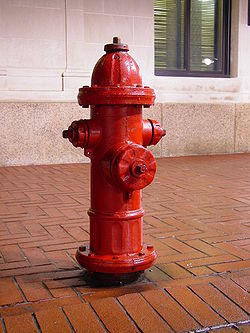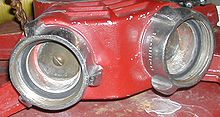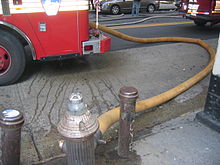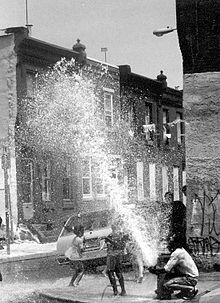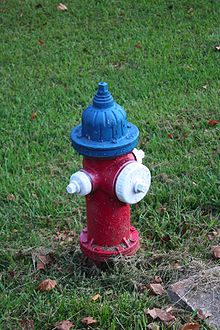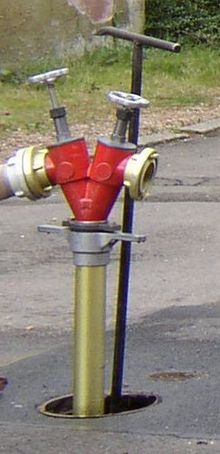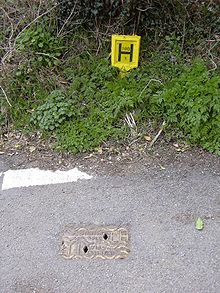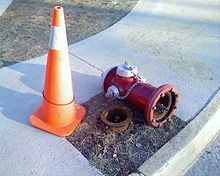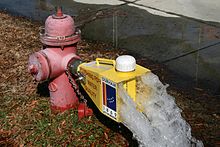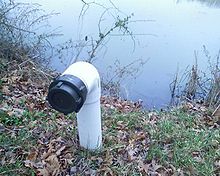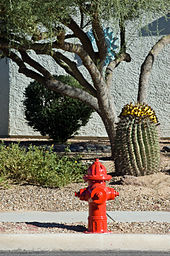- Fire hydrant
-
A fire hydrant (also known colloquially as a fire plug in the United States or as a johnny pump in New York City, because the firemen of the late 19th century were called Johnnies[citation needed]), is an active fire protection measure, and a source of water provided in most urban, suburban and rural areas with municipal water service to enable firefighters to tap into the municipal water supply to assist in extinguishing a fire. Buildings near a hydrant may qualify for an insurance discount since firefighters should be able to more rapidly extinguish a fire on the insured property.
The concept of fire plugs dates to at least the 17th century. This was a time when firefighters responding to a call would dig down to the wooden water mains and hastily bore a hole to secure water to fight fires. The water would fill the hole creating a temporary well, and be transported from the well to the fire via bucket brigades or, later, via hand pumped fire engines. The holes were then plugged with stoppers, normally redwood, which over time came to be known as fire plugs. The location of the plug would often be recorded or marked so that it could be reused in future fires. This is the source of the colloquial term fire plug still used for fire hydrants today. After the Great Fire of London in 1666, the city installed water mains with holes drilled at intervals, equipped with risers, allowing an access point to the wooden fire plugs from street level.[1][2]
The invention of a post or pillar type fire hydrant is generally credited to Frederick Graff Sr., Chief Engineer of the Philadelphia Water Works around the year 1801. It had a combination hose/faucet outlet and was of "wet barrel" design with the valve in the top. It is said that Graff held the first patent for a fire hydrant, but this cannot be verified due to the fact that the patent office in Washington D.C. caught on fire in 1836 where many patent records from that period were destroyed in the process.[3] In 1863, Birdsill Holly invented the modern version of the fire hydrant. While Holly was only one of many involved in the development of the fire hydrant, innovations he introduced are largely responsible for the fire hydrant taken for granted today. In 1869, Holly was issued U.S. patent #94749, for an "improved fire hydrant".[4]
Contents
Operation
A hose is attached to the fire hydrant, then the valve is opened to provide a powerful flow of water, on the order of 350 kPa (50 lbf/in²) (this pressure varies according to region and depends on various factors including the size and location of the attached water main). This hose can be further attached to a fire engine, which can then use a powerful pump to boost the water pressure and possibly split it into multiple streams. The hose may be connected with a threaded connection or a Storz connector. Care should be taken not to open or close a fire hydrant too quickly, as this can create a water hammer which can damage nearby pipes and equipment. The water inside a charged hoseline causes it to be very heavy and high water pressure causes it to be stiff and unable to make a tight turn while pressurized. When a fire hydrant is unobstructed, this is not a problem, as there is enough room to adequately position the hose.
Most fire hydrant valves are not designed to throttle the water flow; they are designed to be operated full-on or full-off. The valving arrangement of most dry-barrel hydrants is for the drain valve to be open at anything other than full operation. Usage at partial-opening can consequently result in considerable flow directly into the soil surrounding the hydrant, which, over time, can cause severe scouring. A hose with a closed nozzle valve, or fire truck connection, or closed gate valve is always attached to the hydrant prior to opening the hydrant's main valve.
When a firefighter is operating a hydrant, appropriate personal protective equipment, such as gloves and a helmet with face shield, are typically worn. High pressure water coursing through a potentially aging and corroding hydrant could cause a failure, injuring the firefighter operating the hydrant or bystanders.
In most jurisdictions it is illegal to park a car within a certain distance of a fire hydrant. In North America the distances are commonly 3 to 5 m or 10 to 15 ft, often indicated by yellow or red paint on the curb. In the UK, yellow lines are used to keep cars from parking over underground hydrants. Parking restrictions are sometimes ignored (especially in cities where available street parking is scarce), however these laws are usually enforced. The rationale is that hydrants need to be visible and accessible in an emergency.
Other uses
To prevent casual use or misuse, the hydrant requires special tools to be opened, usually a large wrench with a pentagon-shaped socket. Vandals sometimes cause monetary loss by wasting water when they open hydrants. Such vandalism can also reduce municipal water pressure and impair firefighters' efforts to extinguish fires. Sometimes those simply seeking to play in the water remove the caps and open the valve, providing residents a place to play and cool off in summer. However, this is usually discouraged as residents have been struck by passing automobiles while playing in the street in the water spray. In spite of this, some US communities provide low flow sprinkler heads to enable residents to use the hydrants to cool off during hot weather, while gaining some control on water usage. Most fire hydrants in Australia are protected by a silver-coloured cover with a red top, secured to the ground with bolts to protect the hydrant from vandalism and unauthorised use. The cover must be removed before use.
In most US areas, contractors who need temporary water may purchase permits to use hydrants. The permit will generally require a hydrant meter, a gate valve and sometimes a clapper valve (if not designed into the hydrant already) to prevent back-flow into the hydrant. Additionally, residents who wish to use the hydrant to fill their in-ground swimming pool are commonly permitted to do so provided they pay for the water and agree to allow firefighters to draft from their pool in the case of an emergency.
Municipal services, such as street sweepers and tank trucks, may also be allowed to use hydrants to fill their water tanks. Often sewer maintenance trucks need water to flush out sewerage lines, and fill their tanks on site from a hydrant. If necessary, the municipal workers will record the amount of water they used, or use a meter.
Since fire hydrants are one of the most accessible parts of a water distribution system, they are often used for attaching pressure gauges or loggers or monitor system water pressure. Automatic flushing devices are often attached to hydrants to maintain chlorination levels in areas of low usage. Hydrants are also used as an easy above ground access point by leak detection devices to detect locate leak from the sound they make.
Construction
In areas subject to freezing temperatures, only a portion of the hydrant is above ground. The valve is located below the frost line and connected via a riser to the above-ground portion. A valve rod extends from the valve itself up through a seal at the top of the hydrant, where it can be operated with the proper wrench. This design is known as a "dry barrel" hydrant, in that the barrel, or vertical body of the hydrant, is normally dry. A drain valve underground opens when the water valve is completely closed; this allows all water to drain from the hydrant body to prevent the hydrant from freezing.
In warm areas, hydrants are used with one or more valves in the above-ground portion. Unlike cold-weather hydrants, it is possible to turn the water supply on and off to each port. This style is known as a "wet barrel" hydrant.
Both wet- and dry- barrel hydrants typically have multiple outlets. Wet barrel hydrant outlets are typically individually controlled, while a single stem operates all the outlets of a dry barrel hydrant simultaneously. Thus, wet barrel hydrants allow single outlets to be opened, requiring somewhat more effort but simultaneously allowing more flexibility.
A typical U.S. dry-barrel hydrant has two smaller outlets and one larger outlet. The larger outlet is often a Storz connection if the local fire department has standardized on hose using Storz fittings for large diameter supply line. The larger outlet is known as a "steamer" connection (because they were once used to supply steam powered water pumps), and a hydrant with such an outlet may be referred to as a "steamer hydrant" although this usage is becoming archaic. Likewise, an older hydrant without a steamer connection may be referred to as a "village hydrant."
Appearance
Hydrant coloring may be due either to purely practical criteria or more artistic. In the United States, the AWWA and NFPA recommend hydrants be colored chrome yellow for rapid identification apart from the bonnet and nozzle caps which should be coded according to their available flow. Class AA hydrants (>1500 gpm) should have their nozzle caps and bonnet colored light blue, Class A hydrants (1000–1499 gpm), green, Class B hydrants (500–999 gpm), orange, and Class C hydrants (0–499 gpm), red. This aids arriving firefighters in determining how much water is available and whether to call for additional resources, or locate another hydrant. Other codings can be and frequently are used, some of greater complexity, incorporating pressure information, others more simplistic. In Ottawa, hydrant colors communicate different messages to firefighters; for example, if the inside of the hydrant is corroded so much that the interior diameter is too narrow for good pressure, it will be painted in a specific scheme to indicate to firefighters to move on to the next one. In many localities, a white or purple top indicates that the hydrant provides non-potable water. Where artistic and/or aesthetic considerations are paramount, hydrants can be extremely varied, or more subdued. In both instances this is usually at the cost of reduced practicality.
In Germany, most hydrants are located below ground (Unterflurhydrant) and are accessed by a Standrohr which provides the connections for the hoses.
Signage
In the UK and Ireland, hydrants are located in the ground. Yellow "H" hydrant signs indicate the location of the hydrants, and are similar to the blue signs in Finland. Mounted on a small post or nearby wall etc., the two numbers indicate the size of the water main (top number) and the distance from the sign (lower number). Modern signs show these measurements in millimetres and metres, whereas older signs use inches and feet.[5] Because the orders of magnitude are so different (6 inches versus 150 mm) there is no ambiguity whichever measuring system is used.
In areas of the United States without winter snow cover, blue reflectors embedded in the street are used to allow rapid identification of hydrants at night. In areas with snow cover, tall signs or flags are used so that hydrants can be located even if covered with snow. In rural areas tall narrow posts painted with visible colours such as red are attached to the hydrants to allow them to be located during heavy snowfall periods.
In Australia, Hydrant signage varies, with several types displayed across the country. Most Australian hydrants are underground, being of a ballcock system, and a standpipe with a central plunger is used to open the valve. Due to this, hydrant signage is essential, due to their concealed nature.
- Painted markers — Usually a white or yellow (sometimes reflective paint) triangle or arrow painted on the road, pointing towards the side of the road the hydrant will be found on. These are most common in old areas, or on new roads where more advanced signs have not been installed. These are almost always coupled with a secondary form of signage.
- Hydrant Marker Plates — Found on power poles, fences, or street-signs, these are a comprehensive and effective system of identification. The plate consists of several codes; H (Potable water Hydrant), RH (Recycled/Non Potable), P (Pathway, where the hydrant cover can be found), R (Roadway). The plate is vertically oriented, around 8 cm wide, and 15 cm high. Found on this plate, from top to bottom, are the following features:
- The codes listed above, Potable/Non-potable at the top, Path/Roadway on the bottom of the plate.
- Below this, a number giving the distance to the hydrant (in meters), then a second number below that giving the size (in millimeters) of the water main.
- A black line across the center of the plate indicated the hydrant is found on the opposite side of the road to which the plate is affixed.
- Plates for recycled water have a purple background, as well as the RH code, normal potable hydrants are white, with the H code.
- Road reflectors or Cats eyes – Almost exclusively blue, these are placed on the center line of the road, usually with little indication on which side of the road the hydrant lies. They are visible for several hundred meters at night in heavy rain, further in clear conditions.
Inspection and maintenance
In most areas fire hydrants require annual inspections and maintenance — they normally only have a one year warranty, but some have 5 or even 10 year warranties, although the longer warranty does not remove the need for periodic inspections or maintenance. These inspections are generally performed by the local municipalities but they often do not inspect hydrants that are identified as private. Private hydrants are usually located on larger properties to adequately protect large buildings in case of a fire and in order to comply with the fire code. Such hydrants have met the requirements of insurance underwriters and are often referred to as UL/FM hydrants. Some companies are contracted out to inspect private fire hydrants unless the municipality has undertaken that task.
Some fire hydrant manufacturers recommend lubricating the head mechanism and restoring the head gaskets and O-rings annually in order that the fire hydrant perform the service expected of them, while others have incorporated proprietary features to provide long-term lubrication of the hydrant's operating mechanism. In any case, periodic inspection of lubricates is recommended. Lubrication is generally done with a food grade non-petroleum lubricant to avoid contamination of the distribution system.
Occasionally a stone or foreign object will mar the seat gasket. In this case, most hydrants have a special seat wrench that allows removal of the seat to replace the gasket or other broken parts without removing the hydrant from the ground. Hydrant extensions are also available for raising a hydrant if the grade around the hydrant changes. Without extending the height, the wrenches to remove caps would not clear and the break flanges for traffic models would not be located correctly in case they were hit. Hydrant repair kits are also available to repair sacrificial parts designed to break when hit by a vehicle.
Many departments use the hydrants for flushing out water line sediments. When doing so, they often use a hydrant diffuser, a device that diffuses the water so that it doesn't damage property and is less dangerous to bystanders than a solid stream. Some diffusers also dechlorinate the water to avoid ground contamination. Hydrants are also sometimes used as entry or exit points for pipe cleaning pigs.
Historical inventions and innovations
Before the modern fire hydrant, a primitive fire suppression system was to bury a wooden water pipe (often no more than a hollowed out log) along the streets.
In the event of a fire, teams would dig down to the buried wooden water main and auger a hole in the pipe. And out would come the water to fill buckets with the water, and start a bucket brigade to extinguish the fire. When they were finished, they would need to hammer a wooden plug into the log to stop the flow of water. Hence the origin of the term “fire plug.”
The version of fire hydrants used today were invented by Birdsill Holly of Lockport, New York for his prodigious contributions to the field of hydraulic engineering in the 19th Century. While Holly was only one of many involved in the development of the fire hydrant, innovations he introduced are largely responsible for the fire hydrant taken for granted today. At Holly Manufacturing, he designed machinery for the Lockport water works that allowed water to be pumped under pressure into city mains without a reservoir. Shortly thereafter, Holly came up with his first design for a fire hydrant. Holly's Fire Protection and Water System, an integrated system designed to deliver water under a steady pressure for public safety, brought him worldwide fame in 1863. The system was widely adapted throughout the United States and Canada, and established the standard upon which all current, water distribution systems are based upon. In 1869, Holly was issued U.S. patent #94749, for an "improved fire hydrant".[6]
Non-pressurized (dry) hydrants
In rural areas where municipal water systems are not available, dry hydrants are used to supply water for fighting fires. A dry hydrant is analogous to a standpipe. A dry hydrant is usually an unpressurized, permanently installed pipe that has one end below the water level of a lake or pond. This end usually has a strainer to prevent debris from entering the pipe. The other end is above ground and has a hard sleeve connector. When needed, a pumper fire engine will pump from the lake or pond by drafting water. This is done by vacuuming the air out of the dry hydrant, hard sleeve, and the fire engine pump with a primer. Because lower pressure exists at the pump intake, atmospheric pressure on the pond or lake forces water into part of the dry hydrant above water, into the hard sleeve, and finally into the pump. This water can then be pumped by the engine's centrifugal pump.
Other types
- Water wells are also sometimes classified as fire hydrants if they can supply enough water volume and pressure.
- Standpipes are connections for firehoses within a building and serve the same purpose as fire hydrants in larger structures. Standpipes may be "dry" or "wet" (permanently filled with water).
See also
- Arson
- Active fire protection
- Fire extinguisher
- Fire protection
- Fire sprinkler
- Flushing hydrant
- Hydrant wrench
- Portable water tank
References
- ^ Shaw, Eyre Massey Fire Protection, a Complete Manual of the Organization, Machinery, Discipline, and General Workings of the Fire Brigade of London 1876. Pages 24–26. Retrieved February 26, 2007 from Google Book Search. Description, illustration, and operation of London style wooden fire plugs.
- ^ "Fire Plugs (derivation of the term)". SewerHistory.org. http://www.sewerhistory.org/articles/compon/fireplugs/fireplugs.pdf. Retrieved 21 November 2008.
- ^ "A Bried History of the Hydrant". Fire Hydrant.org. http://www.firehydrant.org/pictures/hydrant_history.html.
- ^ "Fire Service History". Brookside Fire Company Inc.. http://www.brooksidefire.org/fire%20service%20history.aspx.
- ^ "Good Stewardship for Schools' Premises 2009" (PDF). Cambridgeshire County Council. p. 18. http://www.cambridgeshire.gov.uk/NR/rdonlyres/C39CB426-397F-43D0-8D3F-31637BE56C3E/0/GSGuidefoSchools2009.pdf. Retrieved 2011-01-28.
- ^ "Fire Service History". Brookside Fire Company Inc.. http://www.brooksidefire.org/fire%20service%20history.aspx.
Further reading
- U.S. Patent 909 — Issued to John Jorden on September 8, 1838 for "...a new and useful improvement in Fire-Plugs and Hydrants...". This is an early wooden bodied hydrant, the earliest hydrant patent extant; the patent office itself burned to the ground in 1836, taking with it all prior hydrant patents.
- U.S. Patent 37,466 — Issued to Richard Stileman on January 20, 1863. An early iron hydrant, believed the first patented hydrant with the larger size steamer port to supply steam fire engines. Manufactured and marketed as the Stileman hydrant. See also Stileman page at FireHydrant.org.
- U.S. Patent 80,143 — Issued to Zebulon Erastus Coffin on July 21, 1868. This is a cast iron hydrant very similar to modern fire hydrants, it was produced by Boston Machine Co. See also Boston Machine page at FireHydrant.org.
- U.S. Patent 94,749 — Issued to Birdsill Holly on September 14, 1869. Birdsill Holly himself makes no claim in his patent text that he invented the fire hydrant. What is more, his improvements are relatively minor, and today, obsolete. See also Holly page at FireHydrant.org.
- Wohleber, Curt. "The Fire Hydrant". In The American Heritage of Invention & Technology. Winter 2002. Retrieved December 25, 2005. Provides a history with dates of fire hydrant development.
External links
Categories:- Firefighting equipment
- Water industry
- Street furniture
Wikimedia Foundation. 2010.

